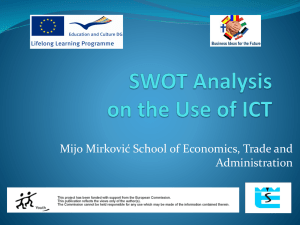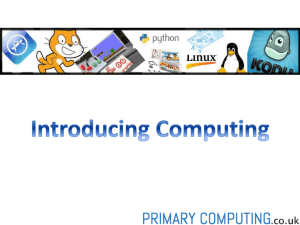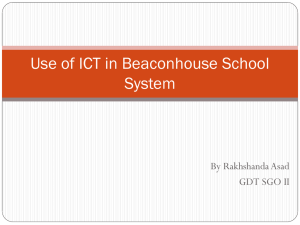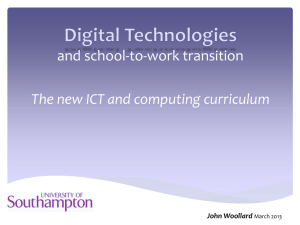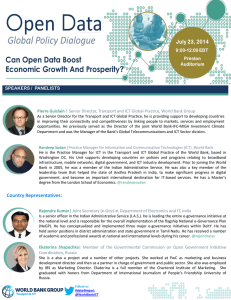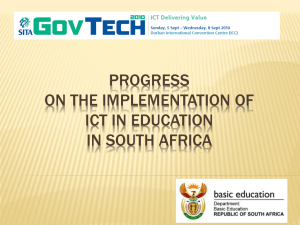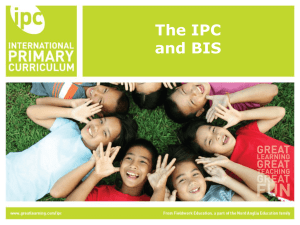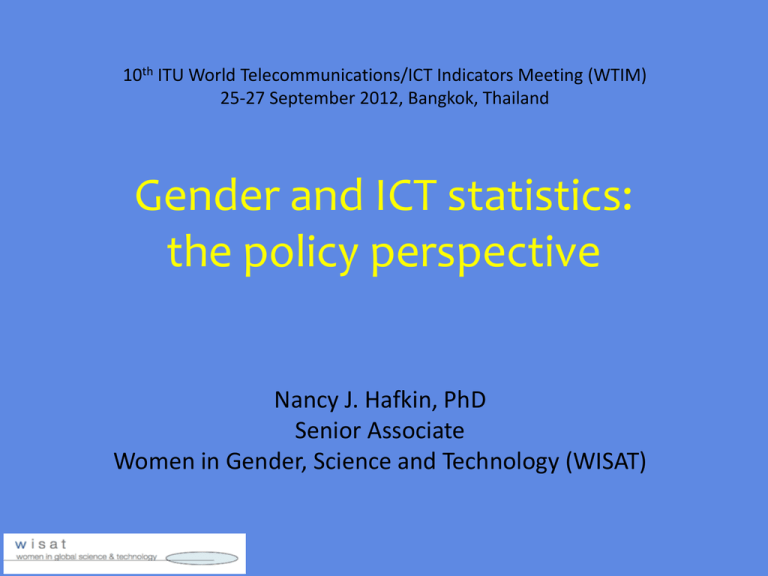
10th ITU World Telecommunications/ICT Indicators Meeting (WTIM)
25-27 September 2012, Bangkok, Thailand
Gender and ICT statistics:
the policy perspective
Nancy J. Hafkin, PhD
Senior Associate
Women in Gender, Science and Technology (WISAT)
Agenda
• Intro to ICT Gender Statistics
• Where we’ve come, ways to go
• Framework on Gender Equality in the
Knowledge Society (GEKS)
• New indicators, Paths for ITU and member
States
2
Intro to ICT Gender statistics
• What are gender statistics?
• Why are they important?
• Why pay special attention to gender in
ICT/telecoms, especially in policy?
3
What are gender statistics?
• Kinds of gender statistics
– Sex-disaggregated statistics
– Gender-sensitive statistics and indicators
• provide a basis for effective development and
implementation of gender-sensitive policy
4
What do ICT/telecoms gender
statistics do?
• Identify and document differential access to,
use of and impact of ICTs by sex in order to
inform national policy and set international
policy goals
• Provide insight into use of ICTs for economic
and social development
5
Why are gender statistics important
for ICT/telecoms policy?
• To learn how men and women experience
ICT/telecoms differently
• To understand the scope and intensity of the
gender digital divide
• To ensure economic efficiency and national
development
– Full utilization of human resources especially
important in global knowledge society
• Called for in ECOSOC and Marrakesh resolutions
6
Without data there is no visibility.
Without visibility there is no priority
• Observations and anecdotal evidence need to
be substantiated.
• We need internationally comparable gender
indicators to inform ICT policy makers,
analysts and other ICT stakeholders.
7
Why special attention to gender?
Doesn’t a rising tide lift all boats?
• Overall ICT/telecoms penetration doesn’t
guarantee equitable access by gender
• Women’s rate of Internet access does not
increase in tandem with increases in national
rates of Internet penetration
• Social, political, and economic inequalities affect
women’s ability to access, use and master ICTs
• Differential access and impact M/F call for special
attention to gender issues to realize gender
equality and full utilization of a country’s human
potential
8
Few ICT/telecoms policies reflect
gender concerns
• Governments tend to regard ICT policy as a
technical issue
• Social and economic concerns often ignored
– Like all technology, ICT is socially embedded
• Need to look at technical policy areas with a
gender lens
• ICT policy does not stand alone. Carryovers
to/from education, health, governance,
agriculture, finance, science and technology
development, all with gender issues.
9
Differentials and
complementarity
• ICTs are not gender neutral; they impact men
and women differently
• But gender equality in ICTs (and other realms)
allows women to be equal contributors to and
participants in knowledge nations
• Desired result: men and women both
contributing to the building of national
knowledge societies
10
How far we have come?
Where we are now?
Where do we have to go?
11
Basic problem: unavailability of
gender statistics
• We’ve come a long way since 2003
• ICT/Telecommunications indicators at that
time
– Female Internet users
– Number (but not levels) of telecommunications
staff by sex
12
What’s being done now
• Training courses on measuring ICT access and use by
households and individuals in developing countries
• Collecting data gathered through official household surveys
since 2005 thru annual questionnaire on ICT access and use
by households and individuals
Through Partnership on Measuring ICT for Development, Core
ICT indicators by gender
–
–
–
–
–
–
Individuals who used a mobile cellular telephone
Individuals who used a computer
Individuals who used the Internet
Location of individual use of the Internet
Internet activities undertaken by individuals
Frequency of individual use of the Internet
13
Gaps remaining . . .
• Data on female Internet users still very sparse
• From sub-Saharan Africa, only Senegal
• Rest of Africa not representative: Morocco, Egypt,
Mauritius
• Major countries missing: China, India
• No data from low-income Asian countries
• More work is needed with Asian and African
countries on statistics ICT use and access and
gender, especially Internet and mobile phones
14
Stand-alone national ICT and
household/individual surveys
• Few stand-alone national ICT surveys, except
in Europe
• Only 23% of developing countries are doing
ICT household/individual surveys
15
Women in Global Science and Society
(WISAT)
Framework on Gender Equality in the
Knowledge Society (GEKS)
16
What is the GEKS framework?
• A data analysis framework for policy makers to
identify economy and society sectors
strategically significant to women’s full
participation in knowledge society
• Access to and use of ICTs are essential and
defining inputs to and outputs of the
knowledge society, but
– Women’s access to and use of ICTs unlikely to be
equitable without consideration of the other
realms that affect gender equity.
17
WISAT Framework on Gender
Equality in the Knowledge Society
• Gender inequities to ICT access and use can
not be addressed through ICT policy and data
alone
• Digital gender gap reflects gender inequalities
throughout societies and economies
• A range of socio-economic and political factors
affect gender divides
18
Questions addressed
• What are preconditions for women to become
full participants in a national knowledge society?
• What resources and access do they need to
achieve this?
• Where and how fast are women making
progress?
• Use the results to answer:
– What policies and programs are most conducive to
promoting women’s participation?
– How can a country mobilize its full human resource
capacity to become a knowledge-based society?
19
Organizing the Framework
Input indicators
(Base conditions)
Outcome indicators
(Participation and benefits)
Health
Social status
Economic status
Access to resources
Agency
Opportunity
Policy environment
Participation in:
KS decision making
Knowledge economy
Science, technology and
innovation
Lifelong learning
20
Knowledge society fails to
include women equally
Seven country/area studies of emerging knowledge societies (2012)
Brazil, India, Indonesia, Republic of Korea, South Africa, USA, EU
• Women few in STI fields in world’s leading economies
– In studies of math, physics, engineering, ICT
– Working in scientific-technical labour force, but decreasing almost
everywhere
– At low levels in decision-making and knowledge economy
• It’s not enough to increase girls’ access to education!
• There must be encouragement to study science and technology
21
Leaders
European
Union
First overall and first or second in every dimension
United States
Second overall, but near the bottom in women’s
health, agency, and social status and low in
enabling policy environment.
Brazil
First in women’s participation in science,
technology and innovation, with a highly enabling
policy environment and effective policy
implementation.
South Africa
South Africa leads in women’s agency, with the
highest numbers of elected and appointed officials,
but low in health (HIV/AIDS) and beset with racial
inequalities.
22
Falling behind
Republic of
Korea
First in health and life expectancy, but Intro
to ICT Gender statistics, second to last overall.
India
Excellent enabling policy environment for
women, but lowest overall among the
countries surveyed, as a result of women’s
low social and educational status.
Absence of any one empowerment factor creates a vulnerability
for economies competitive position in the knowledge society
23
New Indicators,
Paths for ITU and member States
24
What indicators are needed?
• Gender-specific indicators in stand-alone
national ICT surveys:
• Gender-awareness in ICT telecommunications policies
• Gender issues in technical ICT policy areas
• Policy encouragement for girls to study science and
technology
• Women’s share of leading positions in ICT-industry,
government positions in science and ICT
• Women’s participation in telecommunications and ICT
decision-making
25
New indicators: household and
individual ICT access and use
• Mobile ownership
(handset and/or SIM
card)
• Do girls/women have
equal access to all the
ICTs in the home?
•Highly desirable
for all individual
indicators be
disaggregated by
sex
•Especially re
education and
labour force
participation
26
Action Paths for action ITU
• Assume leadership in raising all member
States awareness of sex-differentiated and
gender-sensitive data in
telecommunications/ICT data collection
• Encourage reporting of gender statistics
• Get different policy groups talking to each
other.
– Continue work with UN-Inter-Agency and Expert
Group on Gender Statistics
27
Action Path for member States
• Ensure coordination between NSO and
national telecommunications policy goals, and
between NSOs, ICT policy organs and gender
machineries on data collection
• Ensure gender analysis, gender-awareness in
all ICT and telecommunications statistics and
indicators work
28
Takeaways, please!
• Gender statistics have to be mainstreamed in national
ICT/telecoms statistics and a gender perspective
integrated into ICT telecoms/data collection
• Gender ICT statistics efforts have to be coordinated
with national planning efforts and gender machineries
• Gender advocates must become knowledgeable about
ICT/telecommunications, science and technology
• ICT/telecoms gender statistics have to be seen in
context of overall gender equality
29
Thank you
Nancy Hafkin
nhafkin@gmail.com
For further information on GEKS
www.wigsat.org
30



